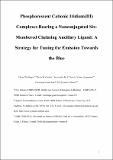Files in this item
Phosphorescent cationic iridium(III) complexes bearing a nonconjugated six-membered chelating ancillary ligand : a strategy for tuning the emission towards the blue
Item metadata
| dc.contributor.author | Hierlinger, Claus | |
| dc.contributor.author | Cordes, David Bradford | |
| dc.contributor.author | Slawin, Alexandra | |
| dc.contributor.author | Jacquemin, Denis | |
| dc.contributor.author | Guerchais, Véronique | |
| dc.contributor.author | Zysman-Colman, Eli | |
| dc.date.accessioned | 2019-03-06T10:57:59Z | |
| dc.date.available | 2019-03-06T10:57:59Z | |
| dc.date.issued | 2018-03-06 | |
| dc.identifier | 252482418 | |
| dc.identifier | 92dbe44d-a6ad-439f-b898-db1bbd864e37 | |
| dc.identifier | 85051259191 | |
| dc.identifier | 000441151700029 | |
| dc.identifier.citation | Hierlinger , C , Cordes , D B , Slawin , A , Jacquemin , D , Guerchais , V & Zysman-Colman , E 2018 , ' Phosphorescent cationic iridium(III) complexes bearing a nonconjugated six-membered chelating ancillary ligand : a strategy for tuning the emission towards the blue ' , Dalton Transactions , vol. In press . https://doi.org/10.1039/C8DT00467F | en |
| dc.identifier.issn | 1477-9226 | |
| dc.identifier.other | ORCID: /0000-0002-5366-9168/work/42504520 | |
| dc.identifier.other | ORCID: /0000-0001-7183-6022/work/56639097 | |
| dc.identifier.other | ORCID: /0000-0002-9527-6418/work/56861739 | |
| dc.identifier.uri | https://hdl.handle.net/10023/17225 | |
| dc.description | C.H. acknowledges the Région Bretagne, France for funding. D.J. acknowledges the European Research Council and the Région des Pays de la Loire for financial support in the framework of a Starting Grant (Marches - 278845) and the LUMOMAT RFI project, respectively. E.Z.-C. acknowledges the University of St Andrews and EPSRC (EP/M02105X/1) for financial support. | en |
| dc.description.abstract | This study concerns an assessment of the impact of the interruption of the electronic crosstalk between the pyridine rings in the ancillary ligand on the photoluminescence properties of the corresponding iridium(III) complexes. Two new cationic Ir(III) complexes, [Ir(dFmesppy)2(pmdp)]PF6, 1 , and [Ir(mesppy)2(pmdp)]PF6, 2 , [where dFmesppy is 2-(2,4- difluorophenyl)-4-mesitylpyridinato, mesppy is 4-mesityl-2-phenylpyridinato and pmdp is 2,2'-(phenylmethine)dipyridine, L1 ] possessing sterically congested cyclometalating ligands combined with the nonconjugated diimine ancillary N^N ligand are reported and their solution-state and thin film photophysical properties analyzed by both experimental and theoretical methods. The crystal structure of 1 confirms the formation of a six-membered chelate ring by the N^N ligand and illustrates the pseudo-axial configuration of the phenyl substituents. Upon photoexcitation in acetonitrile, both complexes exhibit a ligand-centered emission profile in the blue-green region of the visible spectrum. A significant blue-shift is observed in solution at room temperature compared to the analogous reference Ir(III) complexes ( R1 and R2 ) bearing 4,4'-di-tert-butyl-2,2'-bipyridine (dtBubpy) as the N^N ligand. The computational investigation demonstrates that the HOMO is mainly centered on the metal and on both cyclometalating aryl rings of the C^N ligands, whereas the LUMO is principally localized on the pyridyl rings of the C^N ligands. The photoluminescence quantum yield is reduced compared to the reference complexes, a probable consequence of the greater flexibility of the ancillary ligand. | |
| dc.format.extent | 3538369 | |
| dc.language.iso | eng | |
| dc.relation.ispartof | Dalton Transactions | en |
| dc.subject | QD Chemistry | en |
| dc.subject | DAS | en |
| dc.subject.lcc | QD | en |
| dc.title | Phosphorescent cationic iridium(III) complexes bearing a nonconjugated six-membered chelating ancillary ligand : a strategy for tuning the emission towards the blue | en |
| dc.type | Journal article | en |
| dc.contributor.sponsor | EPSRC | en |
| dc.contributor.institution | University of St Andrews. School of Chemistry | en |
| dc.contributor.institution | University of St Andrews. EaSTCHEM | en |
| dc.contributor.institution | University of St Andrews. Organic Semiconductor Centre | en |
| dc.identifier.doi | 10.1039/C8DT00467F | |
| dc.description.status | Peer reviewed | en |
| dc.date.embargoedUntil | 2019-03-06 | |
| dc.identifier.url | http://www.rsc.org/suppdata/c8/dt/c8dt00467f/c8dt00467f1.pdf | en |
| dc.identifier.grantnumber | EP/M02105X/1 | en |
This item appears in the following Collection(s)
Items in the St Andrews Research Repository are protected by copyright, with all rights reserved, unless otherwise indicated.

